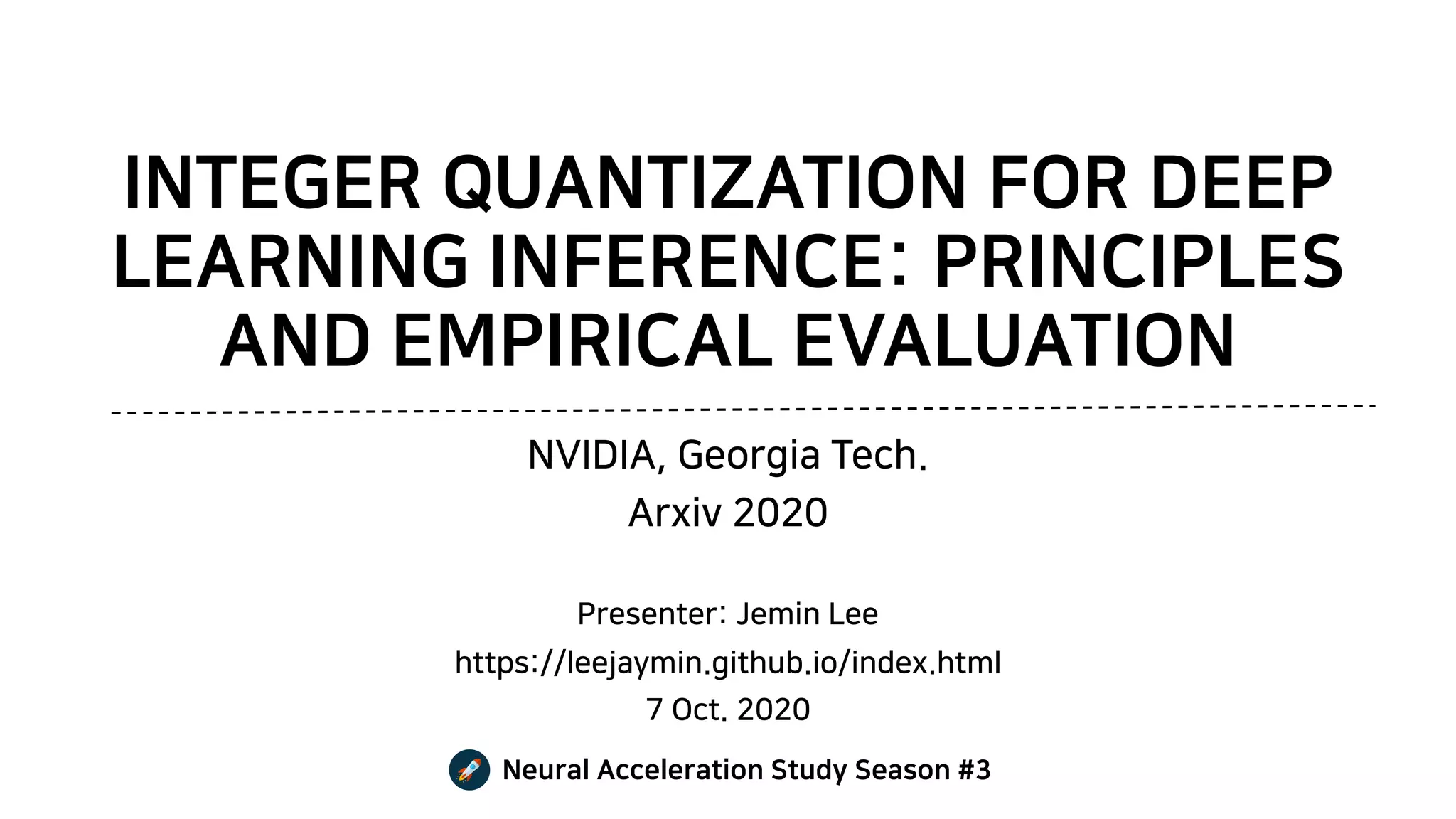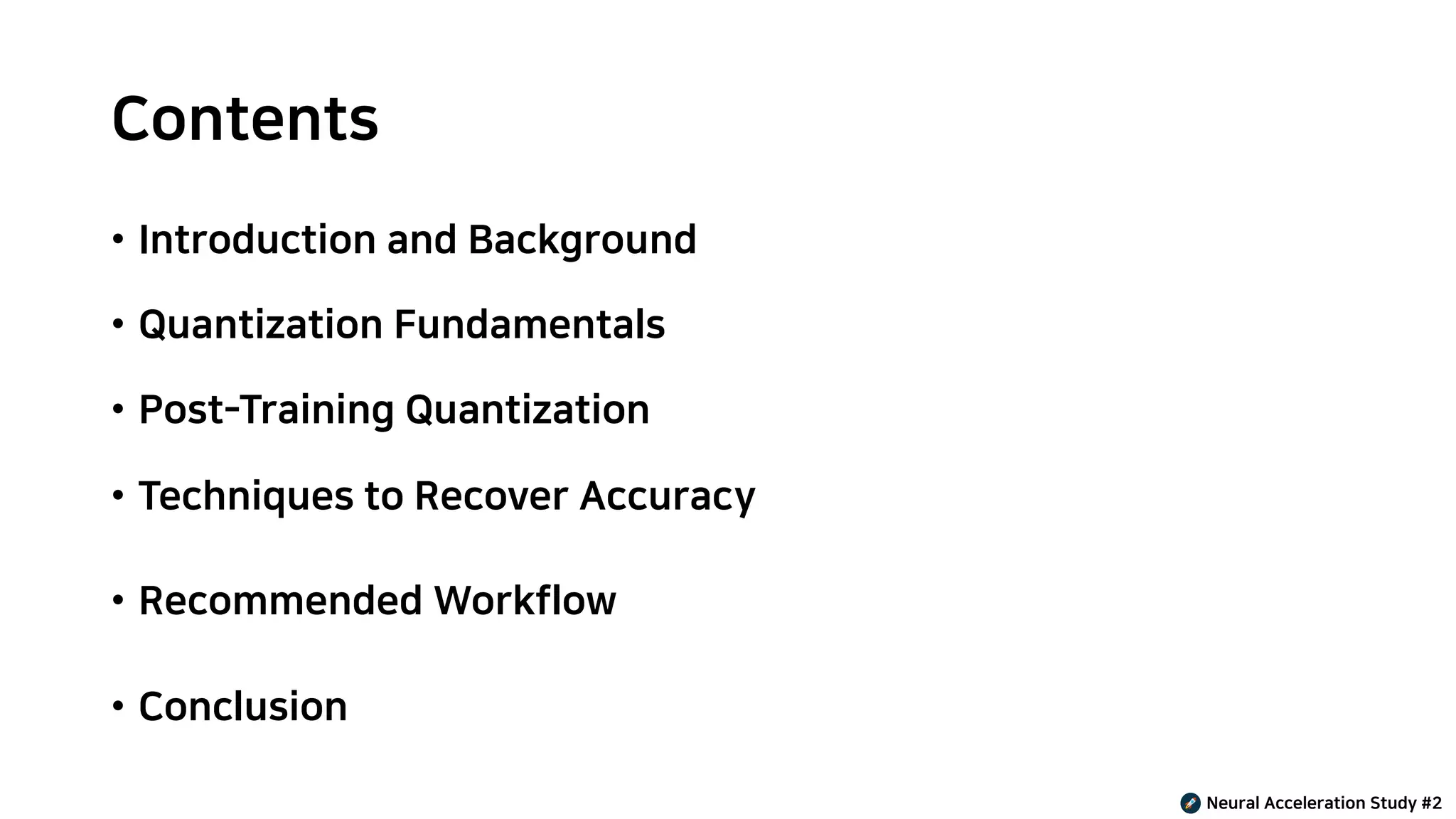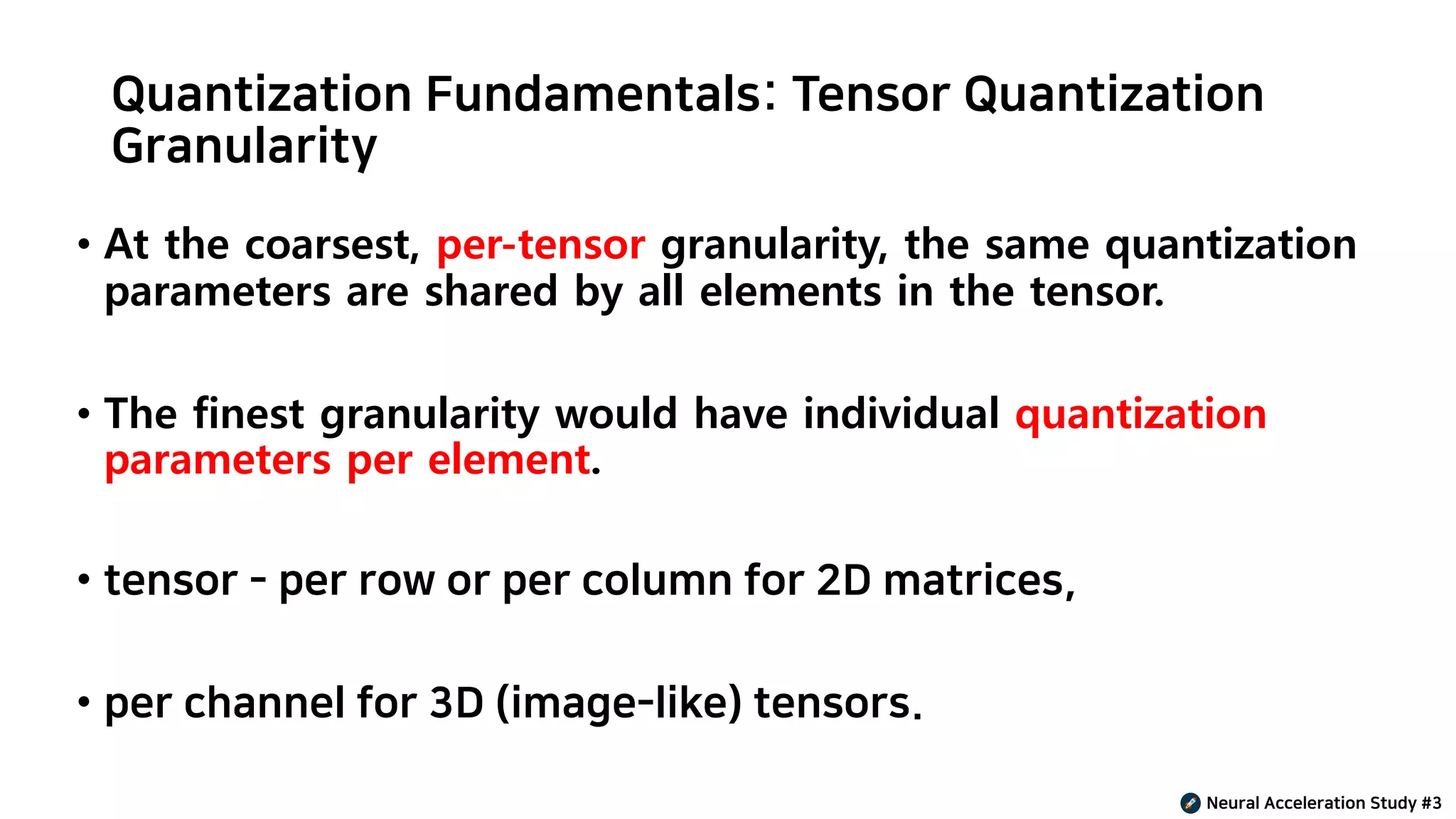The document summarizes a presentation on integer quantization for deep learning inference. It discusses quantization fundamentals such as uniform quantization, affine and scale quantization, and tensor quantization granularity. It also covers post-training quantization, techniques to recover accuracy like partial quantization and quantization-aware training, and recommends a workflow for quantization.




![Related Work
• Uniform [7,59] quantization enables the use of integer or fixed-
point math pipelines, allowing computation to be performed in the
quantized domain.
• Non-uniform[13,60,34,2] quantization requires dequantization, e.g.
a codebook lookup, before doing computation in higher precision,
limiting its benefits to model compression and bandwidth reduction.
• This paper focuses on leveraging quantization to accelerate
computation, so we will restrict our focus to uniform quantization
schemes.
• In this paper, we present an evaluation of int8 quantization on all of
the major network architectures with both PTQ and QAT.
Neural Acceleration Study #3](https://image.slidesharecdn.com/integerquantizationfordeeplearninginferenceprinciplesandempinciplesandempiricalevaluation-201007135938/75/Integer-quantization-for-deep-learning-inference-principles-and-empirical-evaluation-5-2048.jpg)


![Quantization Fundamentals: Scale Quantization
(Symmetric)
Neural Acceleration Study #3
• integer range [−127, 127]](https://image.slidesharecdn.com/integerquantizationfordeeplearninginferenceprinciplesandempinciplesandempiricalevaluation-201007135938/75/Integer-quantization-for-deep-learning-inference-principles-and-empirical-evaluation-8-2048.jpg)


![Quantization Fundamentals: Tensor Quantization
Granularity
Neural Acceleration Study #3
• For activations, only per-tensor quantization is practical for
performance reasons.
• The number of rows depends on batch instances.
• Row count can vary at inference time.
• It prevents the per-row scaling factor from being computation
offline.
• (which would not be meaningful for different instances in a mini-
batch), whereas determining them online imposes a compute
overhead and in some cases results in poor accuracy (Dynamic
Quantization discussion in [58]).](https://image.slidesharecdn.com/integerquantizationfordeeplearninginferenceprinciplesandempinciplesandempiricalevaluation-201007135938/75/Integer-quantization-for-deep-learning-inference-principles-and-empirical-evaluation-11-2048.jpg)
![Quantization Fundamentals: Tensor Quantization
Granularity
Neural Acceleration Study #3
• The corresponding granularity to per-column in convolutions is
per-kernel, or equivalently per-output-channel since each
kernel produces a separate output channel [27, 29].
• This is commonly referred to as “per-channel” weight
quantization in literature and we follow that convention [21,
25, 26, 38, 46]. We examine the granularity impact on accuracy
in Section 4.1.](https://image.slidesharecdn.com/integerquantizationfordeeplearninginferenceprinciplesandempinciplesandempiricalevaluation-201007135938/75/Integer-quantization-for-deep-learning-inference-principles-and-empirical-evaluation-12-2048.jpg)


![Quantization Fundamentals: Calibration
Neural Acceleration Study #3
• Max: Use the maximum absolute value seen during calibration [52].
• Entropy: Use KL divergence to minimize information loss between the original floating-point
values and values that could be represented by the quantized format. This is the default method
used by TensorRT [36].
• Percentile: Set the range to a percentile of the distribution of absolute values seen during
calibration [33]. For example, 99% calibration would clip 1% of the largest magnitude values.
• Clipping the distribution trades off a large clipping error on a few outlier values for smaller
rounding errors on a majority of the values.](https://image.slidesharecdn.com/integerquantizationfordeeplearninginferenceprinciplesandempinciplesandempiricalevaluation-201007135938/75/Integer-quantization-for-deep-learning-inference-principles-and-empirical-evaluation-15-2048.jpg)






![Techniques to Recover Accuracy: Quantization Aware
Training
Neural Acceleration Study #3
• Intuition for QAT
• the model has converged to a “narrow” minimum, since a small change in the weight leads to a large change in loss. By
training with quantization, we may potentially avoid these narrow minima by computing gradients with respect to the
quantized weights, as shown in Figure 6b. In doing so, narrow minima will result in larger gradients, potentially allowing
the model to explore the loss landscape for “wide” [22] or “flat” [16, 30] minima, where quantization points have lower
loss, and thus higher accuracy.](https://image.slidesharecdn.com/integerquantizationfordeeplearninginferenceprinciplesandempinciplesandempiricalevaluation-201007135938/75/Integer-quantization-for-deep-learning-inference-principles-and-empirical-evaluation-22-2048.jpg)


![Techniques to Recover Accuracy: Learning Quantization
Parameters
Neural Acceleration Study #3
• Apply the same fine-tuning schedule as before.
• but allow the ranges of each quantized activation tensor to be learned along with the weights, as opposed to keeping
them fixed throughout fine-tuning.
• Use PACT[1]
• Fixed best: best accuracy with PTQ as described in Table 5.
• Use max calibration for activation quantization
• Learning the range results in higher accuracy than keeping it fixed for most networks.
• In best calibration cases, learning the ranges generate very similar results.
• Not to offer extra benefit for int8 over QAT if activation ranges are already carefully calibrated.
• PACT could yield better results with longer fine-tuning or a separate process.
[1] Pact: Parameterized clipping activation for quantized neural networks, ICLR18](https://image.slidesharecdn.com/integerquantizationfordeeplearninginferenceprinciplesandempinciplesandempiricalevaluation-201007135938/75/Integer-quantization-for-deep-learning-inference-principles-and-empirical-evaluation-25-2048.jpg)
![Techniques to Recover Accuracy: Learning Quantization
Parameters
Neural Acceleration Study #3
• Complex fine-tuning procedure
[1] Pact: Parameterized clipping activation for quantized neural networks, ICLR18](https://image.slidesharecdn.com/integerquantizationfordeeplearninginferenceprinciplesandempinciplesandempiricalevaluation-201007135938/75/Integer-quantization-for-deep-learning-inference-principles-and-empirical-evaluation-26-2048.jpg)


